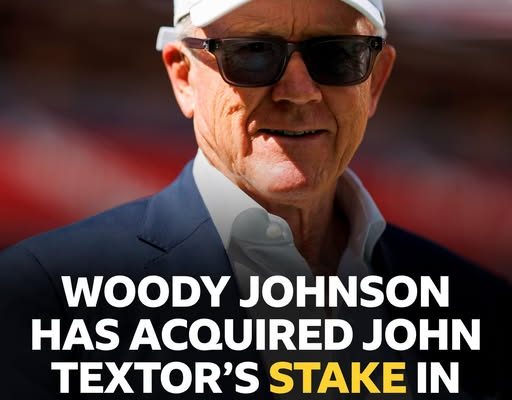New York Jets owner Woody Johnson has officially expanded his sports portfolio beyond American football, completing the acquisition of John Textor’s 43 percent stake in Premier League club Crystal Palace. This monumental move not only signals Johnson’s growing interest in global sports investment but also marks a significant shift in the ownership dynamics of one of England’s most storied football clubs. With the deal finalized, Johnson now becomes a major stakeholder in Crystal Palace, joining the ranks of elite American investors who have made their mark on English football in recent years. The implications of this transaction are far-reaching and suggest an evolving era for both Crystal Palace and the Premier League as a whole.
John Textor’s involvement with Crystal Palace began in 2021, when the American businessman—known for his ambitious sports ventures—purchased a significant minority stake in the club. His influence extended beyond financial investment; Textor brought with him a vision of modernization, international collaboration, and data-driven football strategy. However, as his football empire grew to include other clubs such as Olympique Lyonnais in France and Botafogo in Brazil under his Eagle Football Holdings company, managing multiple teams across continents became increasingly complex. Textor has been vocal about the challenges of juggling different leagues, fan bases, and cultural expectations. Ultimately, those challenges, along with reported friction within the Crystal Palace boardroom, appear to have prompted his decision to exit the Premier League scene.
Woody Johnson’s entry into English football couldn’t come at a more pivotal time. The Premier League continues to thrive as a global commercial juggernaut, and its increasing appeal to American investors highlights the league’s financial and cultural potential. Johnson, a scion of the Johnson & Johnson pharmaceutical dynasty, brings considerable resources and executive experience to Selhurst Park. While some fans might be cautious about foreign investment, particularly when it involves American owners unfamiliar with the deep-rooted traditions of English football, Johnson’s acquisition is likely to be seen as a stabilizing force rather than a disruptive overhaul. His past tenure as the U.S. ambassador to the United Kingdom from 2017 to 2021 also gives him a unique cultural familiarity with the country, which may ease concerns regarding his intentions and knowledge of the British sporting landscape.
Crystal Palace, under the stewardship of chairman Steve Parish, has managed to remain a consistent fixture in the Premier League since gaining promotion in 2013. While not a top-tier powerhouse, the club has carved out a reputation as a gritty, resilient team capable of springing surprises against more established opponents. Recent seasons have seen managerial changes, fluctuating performances, and the nurturing of young talent, including stars like Eberechi Eze and Michael Olise. With Johnson now on board as a key investor, there’s growing speculation about whether the club will push for greater ambition—potentially transitioning from a team merely aiming to avoid relegation to one that could challenge for mid-table prominence or even European qualification in the near future.
The financial implications of this deal are substantial. Textor’s 43 percent stake is valued at a considerable sum, and Johnson’s willingness to invest that kind of capital underscores his long-term commitment. What remains to be seen is how actively involved Johnson will be in the day-to-day operations of the club. American investors vary widely in their level of hands-on involvement—some take a backseat and allow local executives to run the show, while others prefer to embed their own people and philosophies into club operations. Given Johnson’s background as both an NFL team owner and former diplomat, it’s plausible he will strike a balance between delegation and strategic oversight. Regardless, the financial boost from his involvement could pave the way for upgrades in club infrastructure, scouting networks, player acquisition, and youth development.
This ownership change also shines a light on the growing American influence within the Premier League. From the Glazers at Manchester United, to the Fenway Sports Group at Liverpool, to Todd Boehly and Clearlake Capital at Chelsea, American investment in English football is no longer a novelty—it’s a defining trend. With media rights, global merchandising, and brand expansion driving profits, American investors see the Premier League as fertile ground for long-term growth. Johnson’s entrance into this arena suggests he shares that vision and is looking to diversify his sports holdings in a meaningful way. The National Football League and the Premier League, though vastly different in culture and structure, both offer high returns and expansive fan bases. By bridging the two, Johnson positions himself as a key transatlantic figure in global sports.
Still, there are challenges ahead. Crystal Palace fans are known for their passionate loyalty and can be wary of owners who appear disconnected from the club’s ethos. Textor, for all his ambition, occasionally clashed with supporters and board members, especially when his global multi-club model raised questions about loyalty, focus, and resource allocation. Johnson must now navigate these waters carefully. Building trust with supporters and stakeholders will be paramount. Transparent communication, clear strategic planning, and a respect for the club’s history will all be critical in ensuring that his tenure is met with optimism rather than skepticism.
Moreover, there’s the competitive reality of the Premier League. While Johnson’s financial input is valuable, Crystal Palace operates in a league where spending alone doesn’t guarantee success. The club must continue to be smart in its recruitment, innovative in its development pipeline, and cohesive in its footballing philosophy. The recent trend among mid-tier Premier League teams—like Brighton, Brentford, and Aston Villa—shows that strategic intelligence often trumps financial might. Palace would be wise to emulate aspects of those models while carving out their own distinct identity. Johnson’s influence could be especially helpful in bolstering commercial activities, expanding the club’s brand internationally, and perhaps even forging player development pipelines with American and other international markets.
It also bears mentioning that Johnson’s acquisition was executed quietly and efficiently, a sharp contrast to the often chaotic public negotiations that have plagued other Premier League ownership transitions. This suggests a level of professionalism and mutual respect between Johnson and the Crystal Palace board, particularly Steve Parish, who remains an integral part of the club’s leadership. Parish’s role will be crucial in the transition period. As someone deeply embedded in the club’s culture and operations, his continued leadership may provide the necessary continuity as new investment and ideas are integrated into the club’s framework.
In terms of footballing direction, it will be fascinating to see whether Johnson’s involvement accelerates Crystal Palace’s ambitions in the transfer market or changes its long-term sporting strategy. The club has often leaned toward sustainable spending, opting to identify under-the-radar talents and develop them into Premier League-caliber players. The likes of Wilfried Zaha (before his departure), Eze, and Olise have demonstrated the success of this approach. However, should Johnson choose to make a more immediate impact, Palace could become more aggressive in acquiring experienced players capable of propelling the team up the league table. That said, any deviation from the current approach would need to be carefully managed to avoid disrupting the club’s financial stability or squad chemistry.
For Johnson, this acquisition is more than a business decision—it’s a statement of global sporting ambition. The New York Jets remain one of the most valuable franchises in American sports, despite a long championship drought and frequent on-field struggles. Now, with his eyes set on English football, Johnson has the opportunity to reshape the fortunes of a historic London club while simultaneously elevating his status as a global sports magnate. If managed properly, this dual ownership model could foster creative synergies between his two teams, such as marketing campaigns, brand collaborations, and even cross-promotional fan events. Whether that vision materializes remains to be seen, but the potential is certainly there.
Crystal Palace supporters, for their part, will be watching closely. The memories of previous ownership uncertainties and the emotional connection to the club’s identity mean that fans are not likely to accept superficial changes or misguided commercial ventures. What they will embrace, however, is a coherent plan for growth, a commitment to community involvement, and investment in both the first team and youth academy. Johnson’s early moves as a new co-owner will likely set the tone for how his tenure is received. Authentic engagement—attending matches, meeting with fan groups, respecting club traditions—could go a long way in establishing his credibility.
In closing, Woody Johnson’s purchase of John Textor’s stake in Crystal Palace is a significant moment for both the club and the broader Premier League landscape. It marks the end of one chapter and the beginning of another, filled with both promise and uncertainty. For Johnson, it’s a chance to expand his influence across the Atlantic and solidify his legacy in the world of sports ownership. For Crystal Palace, it’s an opportunity to evolve while preserving the core values that have defined the club for generations. The football world will be watching closely to see whether this new partnership can deliver results on the pitch and progress off it. In a league where ambition and tradition often clash, finding harmony between the two will be the ultimate test of this transatlantic takeover.



